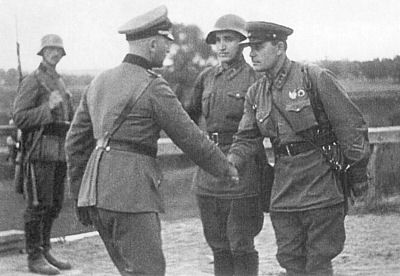THE NEW POLISH EMPIRE
After a century and a quarter of political eclipse, Poland was reborn as a political state at the Versailles Peace Conference. It was made abundantly clear at the Peace Conference that it was not the intention of the Allied Powers to reconstitute a New Polish Empire. The forerunner of the Atlantic Charter—Wilson's famous Fourteen Points—specifically stipulated that "The Polish State shall include territories inhabited by indisputably Polish populations."
 Soviet (official TASS) photograph of Soviet and Nazi officers congratulating each other on the occupation of Poland. — Ed.
Soviet (official TASS) photograph of Soviet and Nazi officers congratulating each other on the occupation of Poland. — Ed.Despite pressure from Polish neo-imperialists and their French backers, British and American influence resulted in the Conference fixing the Polish eastern boundary on an ethnographic basis, on a line running through Grodno, Brest-Litovsk, Rawa Russka and Przemysl, which came to be called the Curzon Line after Lord Curzon, the British representative at the Peace Conference. This ethnographic boundary line recognized by the Versailles Peace Conference1 was precisely the line at which the Red Army stopped when it headed off the Nazi occupation of "Eastern Poland,"2 and is roughly the line which the Soviet Union now considers its boundary with Poland.
But the leaders of the new Polish State could not give up their dream of making Poland a World Power, a dream—given Poland's limited area and population—which could only be realized at the expense of its neighbours. Says Buell in his "Poland": "Pilsudski believed that Poland had to have a large territory.3 For historical reasons it was easier to get this base at the expense of Russia than of Germany." Pilsudski's grandiose ambitions fitted in with Clemenceau's scheme for a Cordon Sanitaire to hem in and ultimately to strangle the Soviet Union.4
| 1 | The line was not recognized, and hostilities continued. |
| 2 | We should note that Stalin occupied Poland in partnership with Hitler. The Soviets transmitted radio signals to guide the invading Luftwaffe. Moscow congratulated Berlin prematurely on the fall of Warsaw. Lastly, in this, yet another partition of Poland by its neighbours, the USSR occupied 51% of Polish territory to Nazi Germany's 49%. At the meeting of invading fronts, German and Soviet troops congratulated the other on the annihilation of Polish sovereignty. (See photo, above.) |
| 3 | As Polish troops drove the Bolsheviks back, the Latvians—in their own War of Independence—had to threaten to attack Pilsudski if he did not evacuate Latvian territory voluntarily. That said, Pilsudski's territorial ambitions were motivated more by territory equating to security than by lust for empire. |
| 4 | While Clemenceau's use of "cordon sanitaire" is the most well-known use of the term, in practice it was a euphemism for the swath of territory western Europe was eager to sacrifice to Russia for its own defence. The Western powers did relatively little to support the states along the USSR's western border during the inter-war period, indeed, they forged economic and security agreements directly with the Soviet Union, such as the British-Soviet economic treaty of 1921 providing de facto recognition of the USSR and the Franco-Soviet mutual assistance treaty of 1935. |
 Gallery
Gallery